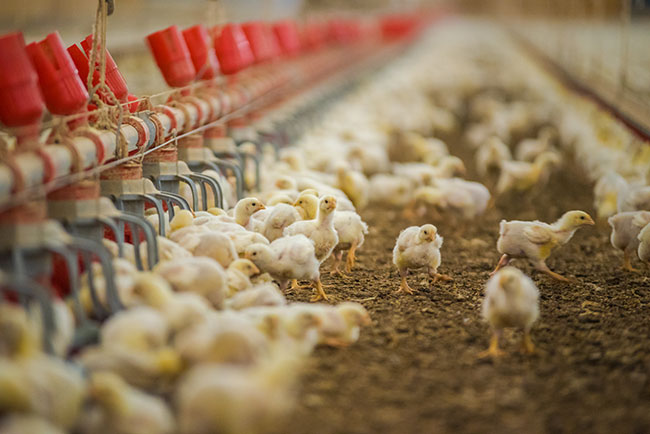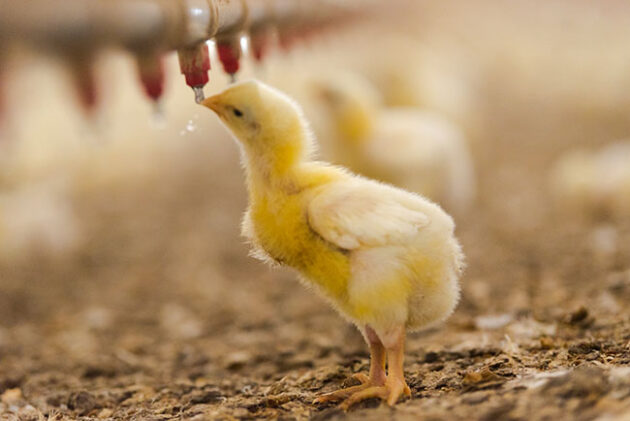
Webinar Series Wrap-up: Combatting poultry plagues
By Lilian Schaer
Features Breeders Broilers Layers TurkeysIn a new Canadian Poultry webinar series, experts shared insights on top diseases affecting poultry, offering strategies for protection and economic resilience.
 The poultry specialists foresee a future safeguarded through vaccination, biosecurity, and expert insights.
PHOTOS: Cobb-Vantress
The poultry specialists foresee a future safeguarded through vaccination, biosecurity, and expert insights.
PHOTOS: Cobb-Vantress Diseases are top of mind concerns for poultry producers and a leading cause of negative economic impacts on-farm. That’s why, this past winter, Canadian Poultry tapped a series of experts to address four of the top diseases currently affecting the industry and highlighting their causes, the on-farm impact and what producers can do to protect their flocks.
Here are the key takeaways they offer for producers.
Inclusion body hepatitis
Inclusion body hepatitis (IBH) is caused by a Type I adenovirus. In Canada, IBH mainly affects meat birds like broilers, and the best way to protect against the virus is vaccinating breeder flocks as there is no live vaccine for broilers.
As birds get older, they become more resistant to IBH, so while outbreaks at three to five weeks of age are common, the level of mortality is much lower than if the outbreaks happen in the first couple weeks of life, when mortality can be 10 to 30 per cent in affected flocks.
How hard an outbreak will hit a flock depends on various factors including whether transmission is vertical or horizontal; what level of maternal antibodies are transmitted; the age of birds at the time they’re exposed to the virus; what type of vaccine is used and how old the breeder flock is; and how much older IBH virus might still be circulating in a farm’s environment from previous outbreaks.

Dr. Babak Sanei, national business & technical manager, Zoetis Canada.
PHOTO:Dr. Babak Sanei
“What’s unique about adenovirus, unfortunately, is that the serotype causing the outbreak must be present in the vaccine used to vaccinate broiler breeders in order to create immunity that can be passed on to offspring,” Sanei notes.
“We would like broiler breeders to have active immunity via natural infection before they come into production, so they transmit antibodies via passive immunity to their offspring; the other way is to vaccinate to induce maternal antibodies and immunity.”
Ontario had a significant IBH outbreak in 2009, primarily caused by serotypes 11 and 8a and after the industry collectively decided to vaccinate all breeder birds, cases subsided significantly. This was a successful approach until 2016, when 8b emerged as a new serotype that is more virulent than the other two as well as being immunosuppressive.
Even when vaccinated, maternal antibodies will wane by 18 to 20 days of age and flocks can still be susceptible to IBH outbreaks, Sanei cautions. This is especially true of the more pathogenic 8b strain, which means producers should also protect their flocks against infectious bursal disease (IBD).
“In my opinion, all broilers need a dose of IBD vaccination at the hatchery followed by monitoring of bursa samples at three to four weeks of age to make sure vaccine is working,” he advises. “Monitoring and diagnostics are critical here as you don’t want IBD and IBH at the same time, especially not 8b.”
Infectious laryngotracheitis
Infectious laryngotracheitis (ILT) is a contagious viral upper respiratory disease primarily of chickens that can cause mortality and production losses. It infects both small non-commercial chicken flocks and larger commercial flocks.
Caused by a herpes virus, outbreaks happen sporadically in most provinces, except in B.C. where the disease is considered endemic and outbreaks happen regularly, particularly in the Fraser Valley where the poultry population is quite dense.
Although birds of all ages are susceptible, ILT typically affects birds older than four weeks. In long-lived birds like breeders and layers, outbreaks tend to occur around peak of lay, so it will cause a decrease in egg production. In affected flocks, 50 to 70 per cent of birds will end up sick, with mortality as high as 10 to 20 per cent. Birds that recover from the disease remain ILT carriers for life and can become sources of infection for future outbreaks.
The incubation period can be six to 12 days, meaning a flock has been infected for some time before clinical signs are detected. Those signs include difficulty breathing, coughing blood, and red, irritated, or blood-filled tracheas, although in mild cases they could be limited to conjunctivitis.
“Call your vet if you see clinical signs, so that birds can be sent to a lab where they will sample tissue to look for the herpes virus,” Carrier says.
Although there is no treatment for the disease once its present in a flock, Carrier says the single biggest action producers can take to protect their birds is to practice good biosecurity and to strengthen those measures if there is an outbreak nearby.
As well, vaccination for all long-lived birds will reduce the severity of lesions and reduce loss. An injection given in the hatchery provides life-long protection against ILT as well as Marek’s disease; vaccination can also be administered by eye drops on the farm.
Commercial broiler flocks aren’t usually vaccinated against ILT except in British Columbia. In Ontario and Quebec, vaccination is recommended for producers inside a 10-km risk zone around an outbreak for at least two flocks following the last case in the region. Most small flocks aren’t vaccinated, which causes preventable losses, Carrier notes.
“No vaccine is 100 per cent effective, but it will help reduce the severity of clinical signs and mortality, reduce the negative impact on productivity and reduce virus shedding,” he says. “Vaccination alone is insufficient; you also need good biosecurity and good sanitation. Reciprocally, biosecurity and sanitation alone may be insufficient, so vaccination makes a difference.”
Enterococcus cecorum
Enterococcus cecorum (E. cecorum) is an old foe presenting new challenges for the poultry industry. It’s a commensal bacterium of the gut microbiota in adult chickens that in Canada usually starts presenting in birds at two to three weeks of age.
Affected birds will show lameness and jumping on one leg, causing a high cull rate. Less commonly now in Canada, it can also present as kinky back in older birds resulting in paralysis. It is very hard to treat, and there are no vaccines available.
E. cecorum tends to reoccur in the same barn sporadically, and as an organism that thrives in cold, humid conditions, it is hard to eradicate from the environment. There are still a lot of unknowns, such as where it comes from, what the causes are and why some birds and barns are affected repeatedly while others are not.
Dr. Lanthier first started seeing cases of pathogenic E. cecoru in antibiotic-free broilers over a decade ago. There are many potential risk factors, but through his work with producers and consultations with industry colleagues, he has developed a short list of the top three that influence pathogenic E. cecorum infections.
These include preventing heat stress in newly hatched chicks, ensuring early access to feed, and cleaning and disinfecting water lines.
According to Lanthier, chicks in their early days are very sensitive to their surroundings and if they’re in an environment that’s too hot for them, it is easier for bacteria to move from their intestines into the blood stream. This means it’s important to ensure uniform light and temperature conditions, as well as a quiet, calmer environment.
Giving chicks immediate and consistent access to feed and water in their early days is also critical. This gives them a steady stream of nutrition during a key period of bone and gut development. Over the first seven days, chicks should never be without feed at any time.
“Aim for 100 per cent of chicks to have consistent access to feed. Evaluate frequently and fix if you see problems,” he advises. “The harder we work on this, the closer we will be to a solution for E. cecorum.”
Good cleaning and disinfection between flocks, as well as leaving more than 14 days of downtime before new birds are placed will help break disease cycles. Thoroughly cleaning water lines is critical, yet often overlooked.
“Waterlines are a most important point as they’re the highway to the chicks’ intestines for E. cecorum and a great reservoir for the virus. Overkill on waterlines will be worth your time and money,” he says.
And finally, keeping a healthy barn environment will help control other diseases that can place additional stress on a young flock.

The prevention of E. cecorum underscores the importance of thorough cleaning and disinfection of water lines.
PHOTO: COBB-VANTRESS
Infectious bursal disease
Infectious bursal disease (IBD) is a highly contagious disease of young broiler chickens that suppresses their immune system and is responsible for major economic losses in the poultry industry worldwide.
It is a stable, hardy virus that is easily transported on vehicles, people, insects, birds, and rodents, and can survive in poultry barns even when thorough cleaning and disinfection protocols are followed.
There are two major serotypes of IBD, but only Serotype 1 is important to the industry as it is pathogenic to broilers and includes standard and antigenic variant strains.
It’s the antigenic variant strains that are causing the majority of IBD- related problems in North America. There are no clinical signs, but they cause the bursa to atrophy, which causes immunosuppression and can result in secondary infections.
In Canada, the most prevalent IBD field strains are NC171 and SA08 and 586, but classic strains stemming mostly from vaccines are also found.
“All pathogenic types of Serotype 1 will cause immunosuppression in chickens and if the bursa is infected by IBD virus and damaged before 14 days of age, the immunosuppression becomes permanent,” he says.
Five main tools are used to diagnose and monitor IBD. The gold standard, notes Amini, is histopathology (by scoring the bursal pathology), but bursa to body weight ratio, PCR and sequencing and blood testing are also used.
Producers are also encouraged to closely monitor flock performance to watch for indicators of IBD, such as:
- increased bird mortality from other diseases;
- an overall increase in the condemnation rate;
- particularly high air sacculitis condemnations;
- an increase in the proportion of under-performing flocks; and
- diagnosis of other immunosuppressive diseases, like Marek’s disease, reovirus or inclusion body hepatitis and others.
Although biosecurity is important for overall poultry health, it is not a practical solution for IBD virus because of its hardiness and easy transmission. That’s why IBD is controlled primarily through vaccination programs; however, thorough cleaning and disinfection helps lower the viral load between flocks, giving vaccines a better chance at working.
Young broiler breeders are vaccinated with modified live or vector vaccines. Breeder hens are also immunized so they will transfer high levels of antibodies to their offspring that will offer protection for one to three weeks. Broiler flocks are vaccinated with modified live, immune-complex or vector vaccines.
“The timing of live vaccination is crucial; if it is done too early while maternal antibodies are still high, the live vaccine virus is neutralized, and if it is given too late, there will be an immunity gap and infection can occur,” he explains.
Regardless of disease, here are good tips to keep in mind:
- Use vaccination as a control if it’s available.
- Thorough cleaning and disinfection between flocks will give fresh birds a better start.
- A healthy barn environment will control other diseases that can stress a young flock.
- Good biosecurity is always important to minimize the risk of problems entering a barn.
Print this page


